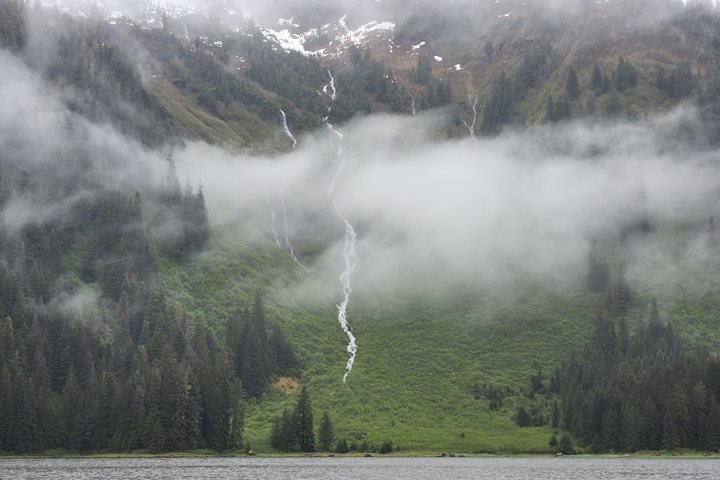At the designated hour of 6 a.m., National Geographic Sea Lion crossed the boundary and entered Glacier Bay National Park under partly cloudy skies with peek-a-boo views of high mountains all around. After a quick look at the scenery we had breakfast and met Linda, our National Park Service ranger and Faith, our cultural interpreter representing the Huna Tribe. Shortly thereafter a commotion arose on the front deck. Three killer whales were cruising through the waters off our port bow—a very uncommon sighting indeed! We reached our first destination, the South Marble Islands. Here we found a sea lion haul-out, a few sea otters, and at least eight different species of birds nesting in the rocks. The crowd favorites were the puffins, of course—both tufted and horned varieties were seen.
At the tidal inlet we had a brief view of a black bear making a quick transit of the beach and disappearing into the shrubbery before most of us could even get on deck. We also contemplated the catastrophic possibilities of a huge mass of rock clinging precariously to the cliff rising above the inlet. A U.S. Geological Survey study indicates that if and when it does fall it could generate a gigantic impact tsunami wave similar to one that occurred on the outer coast of Glacier Bay in 1958. Just up the bay at Gloomy Knob the feature attraction was mountain goats. We first spotted a couple of nannies with their kids snoozing on a grassy knoll. Then as we moved closer more and more goats appeared until the total was 11. The adult goats were shedding their winter coats, giving them a shaggy unkempt appearance compared to the sleek kids who were born in the late spring and early summer.
After lunch we arrived at the end of Tarr Inlet where the Margerie and the Grand Pacific glaciers flow into the sea. The Grand Pacific is not a pretty sight, being covered by rock debris from landslides. In contrast, the Margerie was a beautiful ice blue with delicate towers of ice backlit by the afternoon sun. It also provided us with a bit of excitement as several blocks of ice calved off into the sea. Heading back down the bay we had one last close-up view of the Lamplugh Glacier which has been slowly losing mass to the extent that it is now a tidewater glacier only at high tide.
As we continued, Faith gave a presentation on the essential elements of the Huna Tribe and told some of the stories of their history that she was eligible by her family to tell. This provided us with a much greater understanding and appreciation of the remarkable culture that she represents.
After recap, presentation of Junior Ranger awards, and dinner, we had the opportunity to get off the ship and do a short nature hike or simply wander by ourselves up to the historic Glacier Bay Lodge. Thus we ended an amazing day in a treasured National Park and World Heritage Site.







